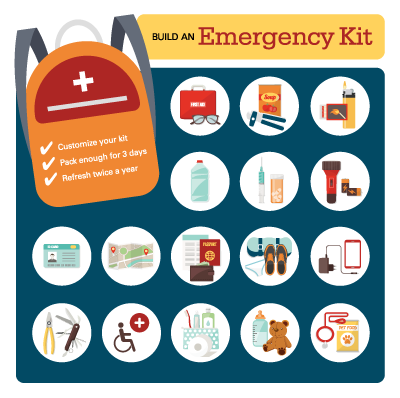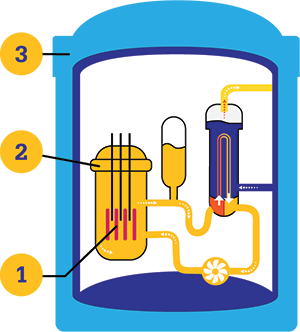How can we help you?


It is important to know which types of disasters could affect your area. Your Emergency Plan will contain emergency contacts, medical information, your Protective Action Zone, evacuation and sheltering information, and more.
Your Emergency Kit should have supplies to last at least three days for each family member. Keep it in an easy-to-carry bag, such as a backpack, duffel bag, or suitcase.
Kit items to include:
Persons with access and functional needs who may need evacuation assistance – Make a Plan. Contact your locality to learn about options and how to sign-up for services. Locality contact information is provided under More Information below.

Not all shelters and hotels accept pets. Plan ahead to stay with family, friends, or at pet-friendly locations if you need to evacuate your home. If a hotel has a no-pets policy, ask the hotel if they can waive the policy during the emergency. Don’t hesitate to leave your home in an emergency because you don’t want to leave your pet(s) behind.
Kit items to include:
The following are pet-friendly hotel resources: bringfido.com, dogfriendly.com, petswelcome.com, and tripswithpets.com.

Local radio and TV stations will have information and actions to take to keep you safe in the unlikely emergency event at North Anna Power Station. The public also will be alerted and notified of an emergency via the Integrated Public Alert and Warning System (IPAWS). IPAWS is FEMA’s national system for local alerting that provides emergency and life-saving information to the public.
In an emergency, an emergency alert will be sent to your emergency alert-enabled mobile device at no charge to you. When you receive an alert on your phone, tune in to local radio or TV station for emergency information and instructions.
Receiving an alert message on your phone does NOT mean you should evacuate. It means turn on your local radio or television station(s) and listen for instructions on what to do.
In order to receive an alert to your phone, you must have a mobile device and be located in the affected area where the alert is being sent. To ensure you receive the alert, go to your mobile phone’s settings, under notifications, scroll to the bottom and confirm all emergency alerts are toggled on. For additional help, visit the Wireless Emergency Alerts tutorial on how to step-by-step enable emergency alert notifications to your phone.
In an emergency parents of school children need to listen to local TV and/or radio station(s) for updates on school status and instructions. Emergency officials will advise schools on what actions to take.
| Radio | TV Station |
|---|---|
Richmond Fredericksburg Culpeper Louisa |
Richmond Charlottesville Washington D.C. |
What Do I Need to Know?
The 10-mile area around the North Anna Power Station is divided into 25 zones, called Protective Action Zones (PAZ). Knowing your PAZ will let you know if your zone is affected by the emergency and what action(s) to take to keep you safe.
Listen carefully to instructions specific to your zone. Not all PAZs may be affected by the emergency or need to evacuate.
If your PAZ is instructed to evacuate, listen for instructions to report to your assigned Evacuation Assembly Center (EAC). EACs offer contamination monitoring, and if recommended, potassium iodide (KI). Learn more about Potassium Iodide (KI) below.
Service animals and pets are the only animals allowed in the EAC.
A service animal is any guide dog, signal dog, or other animal individually trained to provide assistance to an individual with a disability including, but not limited to, guiding individuals with impaired vision, alerting individuals with impaired hearing to intruders or sounds, providing minimal protection or rescue work, pulling a wheelchair, or fetching dropped items.
A pet is a domesticated animal, such as a dog, bird, rabbit, rodent, or turtle that is traditionally kept in the home for pleasure rather than for commercial purposes, can travel in commercial carriers and be housed in temporary facilities. Household pets do not include reptiles (except turtles), amphibians, fish, insects/arachnids, farm animals (including horses), and animals kept for racing purposes.
19155 Rogers Clark Blvd.
Milford, VA 22514
13496 Liberty School Rd.
Ashland, VA 23005
Prospect Heights Middle School
200 Daily Dr. Orange, VA 22960
Chancellor High School
6300 Harrison Rd.
Fredericksburg, VA 22407
8201 Patriot Highway (U.S. 1)
Fredericksburg, VA 22407
If Your Protective Action Zone is Told to Evacuate:
If Your Protective Action Zone is Told to Shelter-in-place:
Not every radiological emergency will result in the release of radioactive material. Potassium iodide (or KI), non-radioactive form of iodine, may be recommended as an additional protective measure to help protect your thyroid gland in the event of a radiological emergency. KI tablets will be provided by emergency officials and handed out at your assigned EAC.
For more information on potassium iodide, visit Virginia Department of Health’s potassium iodide webpage.
Livestock and poultry owners are responsible for the care and wellbeing of their animals. Livestock and poultry owners, farmers, and producers should develop and maintain an emergency plan specific to their needs to use in the case of an evacuation.
Nuclear plant emergencies may impact livestock, food, and agricultural products. Protective actions for livestock and agricultural products will be issued by appropriate state and local officials. These actions may include:
For more information about disaster planning for livestock and agriculture, contact your local cooperative extension agent or emergency management office and download the U.S Department of Agriculture’s (USDA) Livestock Preparedness Fact Sheet .
What Do I Need to Know?
Nuclear power plants are designed, engineered, and operated to adhere to stringent safety and security regulations and practices. Multiple layers of safety systems and structures protect the plant and community from an emergency:
There are three fission product barriers (also referred to as protective barriers) that prevent radioactive fission products to release into the environment: (1) fuel cladding, (2) reactor vessel and cooling system, and (3) containment.
The Nuclear Regulatory Commission (NRC) defines four emergency classifications that could occur at a nuclear power station. Dominion Energy would contact federal, state, and local authorities in each of the following situations:

Local and State Contact Information
For additional emergency preparedness and response information specific to your area, visit your local emergency management/public safety agency website, or contact your locality directly.
If you are an individual with access and functional needs that requires evacuation assistance in an emergency, complete your locality’s registry form or contact the number provided by your locality to see what services are available:
Caroline County
Office: 804-633-9831
Individuals with access and functional needs needing evacuation assistance, contact 804-633-9831.
To receive local alerts and information from Caroline County, subscribe to Caroline Alert.
Hanover County
Office: 804-537-6195
Individuals with access and functional needs needing evacuation assistance, contact 804-365-4148.
To receive local alerts and information from Hanover County, subscribe to Hanover Alerts.
Louisa County
Office: 540-967-3491
Individuals with access and functional needs needing evacuation assistance, contact 540-967-3491.
To receive local alerts and information from Louisa County, subscribe to CivicReady Citizen Alert.
Orange County
Office: 540-672-7044
Individuals with access and functional needs needing evacuation assistance, contact 540-672-7044.
To receive local alerts and information from Orange County, subscribe to RaveAlert.
Spotsylvania County
Office: 540-507-7900
Individuals with access and functional needs needing evacuation assistance, contact 540-507-7900, or go to the Spotsylvania Social Services website.
To receive local alerts and information from Spotsylvania County, subscribe to SpotsyAlert.
Virginia Department of Emergency Management
Office: 804-750-8845 (or toll free at 800-468-8892)
Visit the VDEM website for emergency preparedness and response information for all types of hazards.
Virginia Department of Health’s Radiological Health
Provides radiological health and other emergency preparedness and response information.
Call VA 2-1-1 for information on all kinds of topics, including school closures, evacuation assembly center, emergency preparedness and other emergency planning topics.
Dominion Energy
Call Dominion Energy toll-free at 833-380-6404 for more information about nuclear power station operations and preparedness, or to request a hard copy of this information mailed to you at no cost.